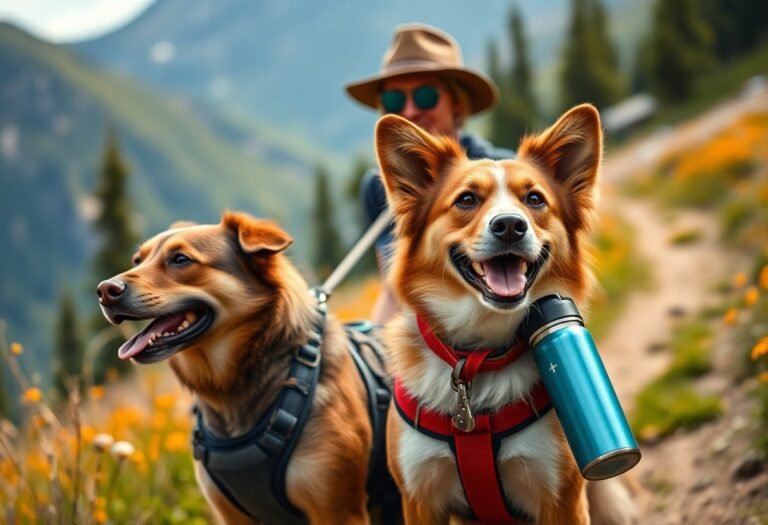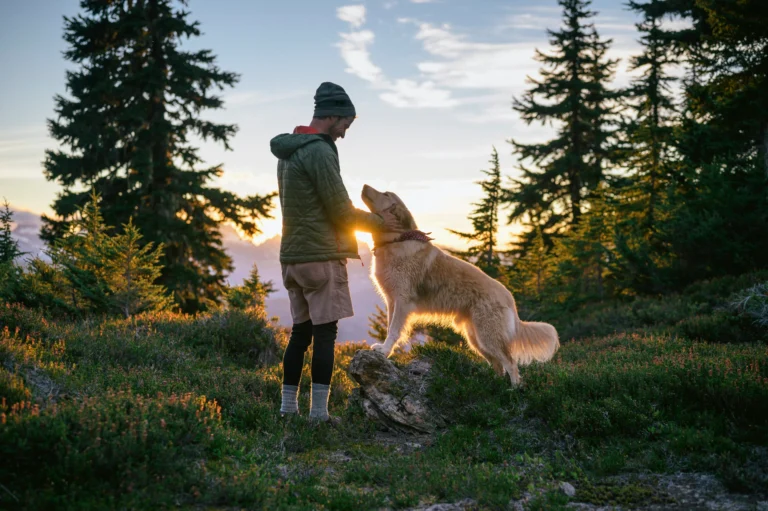You owe it to your furry companion to ensure their safety while exploring the great outdoors. This guide will provide you with vital tips and strategies to protect your dog during adventures on the trail. From choosing the right gear to navigating potential hazards, you will learn how to keep your best friend secure and happy on every hike. Whether you’re a seasoned trailblazer or a newcomer, this information will enhance your outdoor experiences together.
Key Takeaways:
- Always pack imperative supplies, including water, first aid kits, and identification tags for your dog.
- Be mindful of weather conditions and adjust your plans to ensure your dog’s comfort and safety.
- Stay on marked trails to avoid hazards and keep your dog secure from wildlife encounters.
Preparing for the Adventure
Before setting off on the trail, thorough preparation ensures a safe and enjoyable experience for both you and your dog. Start by assessing your dog’s fitness level and endurance, as not all dogs are suited for long hikes or rough terrains. Plan your route carefully, considering distance and terrain type, and familiarize yourself with any potential hazards. Additionally, check the weather forecast to dress appropriately and pack necessities like extra food, water, and a first aid kit tailored for your canine companion.
Choosing the Right Gear
Selecting the appropriate gear for your dog is necessary for their comfort and safety on the trail. Invest in a well-fitting harness or collar, and consider a sturdy leash that provides control without being restrictive. Dog boots can protect their paws from rough terrain, while a doggy backpack can help them carry their own supplies, promoting responsibility without overburdening them.
Health Checks Before Hitting the Trail
A health check is fundamental to ensuring your dog is ready for the adventure ahead. Schedule a visit to the veterinarian to assess your dog’s overall health and discuss any breed-specific concerns, such as hip dysplasia or heart conditions, especially if you’re planning a strenuous trek.
Prior to any adventure, conduct a health check to identify any potential issues that may affect your dog while hiking. Assess their weight, hydration levels, and any signs of fatigue or discomfort in their joints. Additionally, ensure vaccinations are up to date, particularly for Lyme disease if you’re venturing into tick-infested areas. This will not only safeguard their health during your trip but also provide peace of mind knowing your furry friend is physically fit and ready to enjoy the journey with you.
Essential Safety Tips
When adventuring with dogs, implementing safety practices can make all the difference in ensuring a pleasant experience for both you and your furry friend. Start by keeping your dog on a leash to prevent unexpected encounters with wildlife or other hikers. Ensure your dog wears an ID tag with your contact information. Be aware of your surroundings, checking for potential hazards such as steep drops or aggressive animals. Before heading out, confirm the trail is dog-friendly and suitable for your pup’s energy level.
- Always carry a first aid kit for both you and your dog.
- Check the weather beforehand to prepare appropriately.
- Clean up after your pet to maintain trail integrity.
- Observe local leash laws and wildlife regulations.
- Keep your dog calm during encounters with strangers or other pets.
Knowing these necessary tips can enhance your outdoor adventures and ensure safety for everyone involved.
Hydration and Nutrition
Your dog’s hydration and nutrition are vital during outdoor activities. Always carry enough water for both you and your dog; a general rule is about half an ounce of water per pound of body weight daily. Consider packing high-energy snacks like dog-friendly jerky or kibble to keep your dog energized on longer hikes. If the weather is warm, provide frequent breaks in shaded areas to prevent overheating.
Trail Etiquette with Dogs
Trail etiquette is key to a harmonious hiking experience. Always yield the right of way to other hikers and bikers, especially when they have leashed or uncontrolled dogs. When encountering wildlife, keep your dog leashed and maintain a distance. Teach your dog basic commands to help manage their behavior on the trail, ensuring they remain calm and composed. By respecting other trail users and natural surroundings, you foster a more enjoyable environment for everyone.
Understanding and following trail etiquette not only enhances your experience but also sets a positive example for other dog owners. For instance, if you see another hiker approaching, step to the side and allow them to pass, creating a considerate atmosphere. This is particularly important in crowded areas or if a dog is feeling anxious. Carrying a leash enables you to control your dog when meeting other trail users, preventing potential conflicts. Practicing good trail manners ensures that you, your dog, and others can safely enjoy the great outdoors.
Navigating Different Terrains
Each type of terrain presents unique challenges and opportunities for you and your dog. Understanding the nuances of various environments ensures that you can adapt your adventure plans, keeping your furry friend safe and comfortable. From rocky trails to sandy shores, being prepared can help prevent accidents and enhance your overall experience.
Hiking in the Woods
When hiking in the woods, stay alert for natural obstacles like fallen branches and uneven ground. It’s vital to keep your dog on a leash to prevent them from straying into dense underbrush where wildlife may be encountered. Additionally, be cautious of ticks and other pests; regular checks and preventative measures like tick treatments are advisable.
Beach and Water Safety
Exploring the beach is an exhilarating experience for your dog, but it comes with specific safety considerations. Ensure your dog is comfortable in water and supervise them closely to prevent drowning or dehydration. Watch for dangerous currents and keep them away from jellyfish or sharp shells that may cause injury.
Before heading to the beach, check if it’s dog-friendly and look for designated areas. Hydration is vital; always provide fresh water to prevent your dog from drinking seawater, which can lead to vomiting and dehydration. If your dog is new to the water, introduce them gradually and monitor their reactions to help build their confidence. Use a floating toy to encourage play while keeping an eye out for potential hazards like rocks or deep areas.
First Aid Basics for Dogs
Being prepared with first aid knowledge can make a significant difference in your dog’s well-being during outdoor adventures. Familiarize yourself with how to assess injuries, perform basic treatments, and when to seek veterinary care. Quick thinking and the right techniques can alleviate suffering and potentially save your pet’s life.
Common Injuries and How to Treat Them
Common injuries for dogs on the trail include cuts, scrapes, and insect bites. For minor cuts, clean the area gently with water, apply antiseptic, and cover it with a bandage. For scrapes, ensure that the wound is free of debris and apply a topical antibiotic. Insect bites may cause swelling and discomfort; applying a cold compress can soothe your dog’s pain.
Essential First Aid Kit Items
A well-stocked first aid kit is crucial for any dog owner initiateing on an adventure. Include items like sterile gauze, adhesive tape, antiseptic wipes, tweezers, and a digital thermometer. A muzzle can also be beneficial, as it prevents biting if your dog is in pain.
Your first aid kit should be tailored to your adventure style and your dog’s specific needs. Including items like a stretch bandage for sprains, activated charcoal for toxin ingestion, and a pair of scissors can enhance your preparedness for unexpected situations. Moreover, adding a copy of your dog’s medical records can be helpful when seeking veterinary assistance in emergencies. Check your kit regularly to replace expired items and ensure completeness before each trip.
Dealing with Wildlife Encounters
Wildlife encounters can happen unexpectedly while hiking. Understanding how to react to these situations is vital for both your safety and your dog’s. Whether you spot a bear, deer, or snake, keeping your distance is key. Learn more about safe practices when venturing outdoors with your pet in this Hiking with Dogs guide.
What to Look Out For
Being aware of your surroundings is vital. Look for signs of wildlife activity, such as tracks, droppings, or noises. Sudden changes in your dog’s behavior can indicate their awareness of nearby animals. Keep an eye out for common wildlife like raccoons, coyotes, and birds of prey that may pose a risk to small dogs or your own safety.
How to Safely Handle Wildlife Interactions
In any wildlife encounter, prioritize safety by keeping your dog close and leashed. Avoid direct eye contact with the animal and back away slowly without turning your back. If the animal approaches, stand your ground and make noise to discourage it from coming closer. Ensuring that your dog remains calm and obedient can prevent escalating the situation.
If you find yourself facing wildlife, assess the situation calmly. For example, if a deer appears, keep your distance and allow it to move along. In contrast, if you encounter a bear, avoid any sudden movements and speak firmly while backing away. If the wildlife displays aggressive behavior, sound a whistle or shout to deter them. Always be prepared with a safety plan—carry bear spray or a similar deterrent based on your hiking region. Awareness and preparedness are your best defenses.
Post-Adventure Care
After your adventure, taking the time to care for your dog ensures their health and happiness. This involves thorough grooming, monitoring for any signs of distress, and providing proper hydration and nutrition to help them recover from their outdoor activities.
Grooming and Clean-Up
Post-hike, grooming your dog is vital to remove dirt, twigs, and ticks that may have attached during the adventure. Use a comb or brush suitable for their coat type to eliminate debris, and give them a bath if they’re visibly dirty. Inspect their ears and paws, cleaning any mud or debris to prevent irritation or infection.
Monitoring Health After the Hike
Observing your dog’s behavior after an adventure can provide vital clues about their health status. Watch for any signs of fatigue, limping, or unusual behavior, which could indicate injury or fatigue. It’s important to check their hydration levels and appetite, ensuring they are returning to their normal routines.
Pay attention to specific signs of health issues, such as excessive panting or reluctance to move, which may signal overheating or injury. Monitor their paws for cuts or abrasions and inspect for any ticks or parasites that may have hitched a ride. If you notice unusual symptoms that persist, consider consulting your veterinarian for further evaluation. Keeping an eye on your dog’s health for the days following your hike is a smart way to ensure they stay in top shape.
To wrap up
Following this guide will empower you to take vital steps in ensuring your dog’s safety on outdoor adventures. By equipping yourself with knowledge about trail hazards, hydration needs, and pet etiquette, you can focus on enjoying quality time with your furry friend. Always carry a first aid kit, maintain awareness of your surroundings, and plan ahead for varying conditions. With proper preparation, you can create lasting memories while keeping your best friend secure and happy on every trail you explore together.
FAQ
Q: What vital gear should I bring for my dog on a trail adventure?
A: Essential gear includes a sturdy leash, a well-fitted harness, a portable water bowl, dog-friendly snacks, a first aid kit, and a doggy backpack if your dog can carry some supplies. Additionally, consider a lightweight dog jacket for varying weather conditions.
Q: How can I protect my dog from wildlife encounters while hiking?
A: Keep your dog leashed at all times to prevent unexpected wildlife interactions. Stay on marked trails, make noise to alert animals of your presence, and educate yourself on the wildlife in your area, including what to do if you encounter them.
Q: What should I do if my dog gets injured on the trail?
A: Assess the injury and determine if your dog can continue. If it’s serious, apply first aid if trained, and try to keep the dog calm and still. If you cannot safely carry your dog, call for help. Always have a plan for transportation in case of emergencies.






